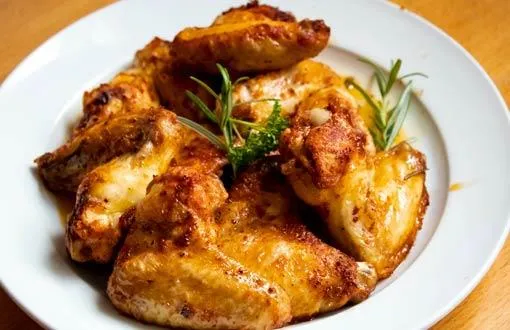Roast Chicken Croquettes
Ingredients
- Roast chicken or any cooked chicken: wings, grilled breast, drumsticks… you can use leftover chicken from the day before.
- Wheat flour. If you replace it with wholemeal flour, oat flour or chickpea flour, your recipe will be healthier.
- Milk
- Onion
- Olive oil
- Butter
- Salt
- Pepper
- Nutmeg
- Eggs
- Bread crumbs

Preparation
- Finely chop the chicken.
- Sauté the onion in olive oil and strain the oil to add it to the béchamel.
- Toast the butter and flour with nutmeg, salt and pepper.
- Add the milk and let the béchamel cool.
- Shape the croquettes with care.
- Fry them in hot oil.
- That’s it.
The chicken: tasty, affordable and healthy
The rooster, hen or domestic chicken is the most numerous bird on Earth, with a population estimated between 25 and 35 billion, half of them in Asia.
We commonly call it “chicken” when the bird hasn’t yet reached adulthood.
The annual global production of chicken meat reaches 100 million tonnes, and egg production 75 million tonnes (around 600 billion eggs). Meat and eggs are the main chicken-derived foods for humans.
Under normal conditions their lifespan ranges from 5 to 10 years. They dislike salty food and cannot distinguish sweet flavours. They are omnivorous and insectivorous.
Roosters have a red comb, stand around 50 cm tall and weigh about 4 kilos. If not castrated, they crow at dawn as a territorial or alert call and produce a characteristic “cocó” sound during mating periods.
Hens weigh around 2 kilos and measure about 40 cm. A “broody hen” is a mother that stops laying eggs to incubate them.
Due to thousands of years of domestication, chickens can barely fly today. Only some wild species can fly short distances to escape predators.
Chicken domestication began in the Neolithic, when hunter-gatherer tribes settled near farmland and livestock. We’re talking about roughly 7,500 years ago in Southeast Asia, China and India.
The second stage took domestic chickens to the Near East, Egypt and Mesopotamia.
They reached what we now call Europe 2,500 years ago. In the Middle Ages, chicken meat was considered a fine delicacy.
The global popularity of chicken today is due to its low cost and its presence as a key ingredient in fast food.
A curious fact: cockfights have existed for more than 2,500 years, though their cruelty has led to bans in most countries. China, the Roman Empire, India, the Philippines and South America were areas where they were particularly popular at certain times in history.
In the USA chickens are even kept as pets, although they have many domestic predators, which makes them a rare choice for companionship.
Chicken meat is such a staple that it’s used as a major indicator in inflation indexes worldwide. When chicken prices rise or fall, inflation reacts immediately.
Chickens raised for meat rarely reach 20 weeks of age before slaughter. They usually weigh between 1 and 3 kilos.
Its boom in global consumption began during the golden years of the 1960s, when it stopped being considered a luxury item.
Almost every part of the chicken is used, except for the internal organs, though in Japan even those are used in certain culinary preparations.
Chicken can be enjoyed in countless ways:
In croquettes
As cold cuts
Fast food
Grilled or barbecued
Roasted
Fried (breaded or not)
Stewed
Ground
To add flavour and texture to soups and broths
Most of the chicken’s composition is water, followed by proteins. It is low in fat, except for the skin.
Minerals: iron, zinc, magnesium, selenium, cobalt, phosphorus… Vitamins: A, B1, B2 (riboflavin), B3, B6 and B12.
Its consumption can help with relaxation and low-mood periods. It’s good for bones and teeth, does not contribute to weight gain and helps maintain healthy blood pressure.
As always, consult a qualified healthcare professional regarding your personal dietary needs.
The three main types of chicken
Industrial or farm chicken: the most common and affordable. Fed with feed, low mobility.
Free-range chicken: smaller in size, very flavourful.
“Picantón”: slaughtered at around one month of age, weighing no more than half a kilo. Tender and delicate. Ideal for grilling or roasting.
Other varieties
Capón: castrated and overfed male. Fatty, aromatic meat. Can reach up to 4 kilos.
“Tomatero”: fed mainly on fresh tomatoes. Distinctive flavour. Weighs between 500 grams and 1 kilo.
Pularda: female that has not laid eggs between 6 and 8 months of age. Can reach up to 3 kilos. Intense flavour and tender texture.
Old hen: older female that no longer lays eggs. Tough meat, perfect for broths and stews.
Top 5 global chicken producers: USA, Brazil, China, Russia and India.
In Spain we consume around 50 kilos of meat per person per year, 70 percent of it fresh. Chicken accounts for 12 to 15 kilos per person per year.
Chicken croquettes are a true institution in Spanish homes. No two are alike. What’s your secret for making them so tasty?
Esta entrada también está disponible en:
![]() Español
Español
